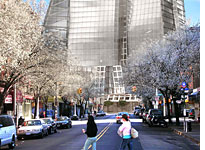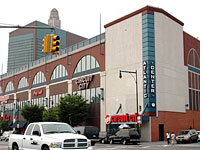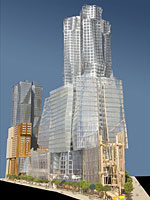I nearly missed this. Thank you Curbed for bringing it to my attention. It’s from Slate.com
Dear Frank Gehry,
We’ve
never met, but last month I sent you a letter. You didn’t answer, so
I’m trying again. I’m a novelist who grew up in the Boerum Hill
neighborhood of Brooklyn, and who lives there now (I’ve also lived in
Oakland, Toronto, and in rural Maine, in case you find my perspective
suspiciously parochial). The subject of my letter is the ill-conceived
and out-of-scale flotilla of skyscrapers you propose to build on a
series of sites between Atlantic Avenue and Dean Street in Brooklyn, in
your partnership with a developer named Bruce Ratner and his firm,
Forest City Ratner Companies.
Most
people, if they’ve heard of this proposal at all, believe you’ve been
hired to design a sports arena, to house the New Jersey Nets, a team
owned by Mr. Ratner. Anyone who’s glimpsed the drawings and models,
however, knows that other, larger plans have overtaken the notion of a
mere arena. The proposal currently on the table is a gang of 16 towers
that would be the biggest project ever built by a single developer in
the history of New York City. In fact, the proposed arena, like the
surrounding neighborhoods, stands to be utterly dwarfed by these
ponderous skyscrapers and superblocks. It’s a nightmare for Brooklyn,
one that, if built, would cause irreparable damage to the quality of
our lives and, I’d think, to your legacy. Your reputation, in this
case, is the Trojan horse in a war to bring a commercially ambitious,
but aesthetically—and socially—disastrous new development to Brooklyn.
Your presence is intended to appease cultural tastemakers who might
otherwise, correctly, recognize this atrocious plan for what it is,
just as the notion of a basketball arena itself is a Trojan horse for
the real plan: building a skyline suitable to some Sunbelt boomtown.
I’ve been struggling to understand how someone of your sensibilities
can have drifted into such an unfortunate alliance, with such
potentially disastrous results. And so, I’d like to address you as one
artist to another. Really, as one citizen to another. Here are some
things I’d hope you’ll consider before this project advances any
further.
 |
|
A projected view of the proposal’s impact on the neighborhood |
1) Brooklyn-based architect Jonathan Cohn’s rallying cry: "It’s the scale, stupid."
The primary objection to your project always was, and always will be,
its outlandish disproportion to the neighborhoods around it. None of
the array of low-scale, largely residential communities directly
adjacent to this proposed "neighborhood from scratch" (your words) want
or need such an intrusion. Residents have been enticed with goodies:
major-league sports in Brooklyn, housing at a variety of income levels,
an influx of jobs. Yet in this case, none of the carrots that have been
dangled are worth it—or, necessarily, realistic. Let me quote Cohn from
his superb article: "The ambitiously scaled projects of the 1960s
failed … because interventions, at that scale, in existing fabric, were
extremely traumatic to the urban morphology. This project (now 8.66
million square feet) would be like locating the former World Trade
Center towers (only 7.6 million square feet combined) plus Madison
Square Garden, somewhere near the West 4th Street transit hub because
of all the trains there." With all due respect to your accomplishments,
you’ve not made your career as an urban planner; your emphasis, rather,
is sculpted steel and glass. The scale of this project was one of
Ratner’s company’s preconditions for the site; it’s not something that
originates in your aesthetic. Guess what? It’s a huge mistake—emphasis
on the huge.
2) Your partner’s manipulative dishonesty. Let me begin with the now-legendary brochure
that Brooklynites found in their mailboxes two months ago; evidence of
bad faith couldn’t be more vivid. The brochure purported to outline
Ratner’s plans, but the towers he and you propose building were hidden
behind corny images of racial harmony and the sunny sidewalks and
low-scale buildings—precisely the stuff soon to be thrown into shadow
at the foot of your epic pylons. The arena rooftop—a private parkland
fantasia, well above ground-level—is palmed off as an open meadow, as
though accessible to the public. The brochure is a piece of mendacious
flimflam. It suggests embarrassment on the part of the company who
hired you: Where are the towers? Obviously, someone thought they would
seem unpalatable to the community that is to be persuaded to live with
them. How can an artist of your standing be willing to sneak in
Brooklyn’s back door?
The appalling brochure is, of course, just
an example. The deeper deceit is in Ratner’s shadow-show negotiations,
in lieu of forging any genuine consensus among the affected
communities. Of the eight community groups supporting his project (as
opposed to this long list of organizations standing for a reconsideration of the project),
six were formed after the project was announced, and seven of the eight
receive funding from Ratner. At least one seems to have been wholly
conceived in Ratner’s PR office. In other words, while claiming a
mandate from community groups, Ratner has essentially negotiated with
himself.
The worst falsehood is also the most basic: Ratner’s
company has fudged its unwillingness to conduct open public meetings
with the community. In its PR world, such a meeting is always on the
verge of taking place. Yet it never does. The public has zero access to
this planning process—in every real sense the project is being foisted
upon them as a fait accompli. In the spirit of calling a liar a liar, let me be absolutely clear: Your partners have been lying to Brooklyn.
 |
|
Ratner’s Atlantic Center mall * |
3)
Ratner’s abhorrent track record. Have you had a close look at what he
has already inflicted on Brooklyn? First came Metrotech, as blandly
Orwellian as its name. Then the shameful failed mall, the Atlantic
Center, dubbed by architectural historian Francis Morrone as "the
ugliest building in Brooklyn." Offered as a supposed benefit to the
local economy, its forbidding design was explained by Ratner to the New York Times thusly:
"Look, you’re in an urban area, you’re next to projects, you’ve got
tough kids." It was behind those chilly facades that you recently
unveiled your latest models, at a tightly managed press conference that
squelched any risk of dissent. How can it have felt for you to stand in
such a horrid structure making your case for your proposed
collaboration with its builder—while shutting out the possibility of
true debate? After all, it’s these dim, soul-crushing buildings that
created such distrust in Brooklynites in the first place.
4) The
divisive zero-sum politics. In a sop to tabloid-level discourse,
Ratner’s PR stance suggests that to stand against this specific
proposal is to stand generally against bringing jobs, housing, and
sports to Brooklyn. Sen. Chuck Schumer even implied that to criticize
this development was to stand against the forces of life itself. He
recently dismissed the opposition as "this culture of inertia, this
small group of self-appointed people … " and ominously warned his
listeners, "If we don’t grow, we die."
You ought to be reluctant
to lend your voice to this crude tactic. Yet we heard you at the latest
press conference suggesting that critics of the proposal "should’ve
been picketing Henry Ford. People aren’t riding around on horseback
anymore." Let me be clear: The vast majority of opponents of the
present proposal are—shockingly!—in favor of creating jobs and housing,
and in favor of progress generally. Many might like to find a way to
bring a major sports team to Brooklyn (and we recall the appealing Coney Island proposal for a sports arena). We’re simply dead-set against the present calamity-in-progress to which you’ve mortgaged your credibility.
When
local politicians speak of the need for growth and renovation in the
partly desolate areas encompassed within Ratner’s footprint, they’re
not wrong. Those of us who have long lived in range of the Atlantic and
Flatbush intersection do connect that area with the vanishing
of the Dodgers and other symbols of Brooklyn’s disappointment and
thwarted potential. It’s precisely that legacy of long expectation that
dictates we not accept a pre-emptive engulfment by a single private
corporation—especially one so imperiously allergic to genuine dialogue
and meaningful compromise, and with such a bad track record.
Plans
for the area ought to originate in a conversation among a broad range
of stakeholders. We might want more than housing and jobs and sports—we
might want schools for the extra kids who’d live in the housing (we’re
already underschooled). We might want a plan to solve the traffic
crisis that already exists at the intersection of Flatbush
and Atlantic, let alone the new crisis that would radiate outward from
this development (currently there is no plan). Ratner hasn’t met openly
with Brooklynites. Have you?
When I begin conversations about the
Ratner development with local friends and neighbors, I find a pervasive
mood of resignation. Despite their disgust at the project, they fear
engaging in a hopeless struggle. What’s saddest is how this lousy
proposal exploits Brooklyn’s residual low self-esteem, its hangover of
inferiority. Does anyone doubt that in Manhattan such a thing would be
shot down in a hot minute?
5) The principle of eminent domain. Actually, the seizure of private property, ostensibly for the public good, doesn’t have an entirely
pernicious history, at least in New York City; the creation of Central
Park, for instance, depended on it. But compare that project with this
one: on the one hand, the permanent establishment of a munificent jewel
of the commonwealth. On the other hand, exclusive benefit and control
for a wholly private corporation. In fact, in the present scheme,
publicly owned resources—i.e., the demapped streets and an active rail
yard—are here being converted into private property: commonwealth in
reverse.
6) A moment’s respect,
please, for the Williamsburg Savings Bank Tower. This homely, absurd
totem, with a clock on each of its four faces, has grown into a
symbolic authority. By sight of this lone 34-story tower, visible for
miles, a Brooklynite arriving home from the airport measures the
infinitesimal rate of his cab’s progress home along the Brooklyn-Queens
Expressway. Your proposal would both dwarf and block sight of the
tower, the rough equivalent
of erecting a new World Trade Center within a block or two of the
Chrysler Building. Adding insult to injury, the Williamsburg Savings
Bank Tower is being enlisted into the argument for your wall of
towers—its anomalous height somehow becoming justification for your
scale.
 |
|
Gehry’s "Miss Brooklyn" |
7)
The drawings themselves. Any chance you want to take a harder look at
your plans? When unveiling the latest, you explained the appearance of
the spearhead tower, which you’ve named "Miss Brooklyn" (spurring the
inevitable quip, We’ll miss it, all right). You explained:
"When we were studying Brooklyn, we happened upon a wedding, a real
Brooklyn wedding. And we decided that ‘Miss Brooklyn’ was a bride.
She’s a bride with her flowing bridal veil—I really overdid it. If you
had seen the bride, you would—I fell in love with her." Pardon me, but bleeechh.
I don’t know whether many great buildings have been founded on notions
at once so metaphorically impoverished and so slickly patronizing. But
somehow I doubt that any have.
You were also quoted as calling
her—Miss Brooklyn, I mean—"my ego trip." Fair enough. It may be the
case that every great artist deserves one work so willful and
outlandish that the public’s taste be damned. Melville’s epic poem Clarel comes to mind, or Bob Dylan’s Renaldo and Clara. The difference, of course, is that no one was ever forced to read Clarel or sit through Renaldo and Clara.
An architect infilling an existing cityscape at such Titanic scale
becomes, by definition, an urban planner, yet something makes me think
that you haven’t done that kind of homework here. Anyway, is Miss
Brooklyn really good enough—as opposed to merely big enough—to be your
ego trip? To my unschooled eye, these buildings have emerged
pre-botched by compromise, swollen with expediency and profit-seeking.
(Don’t forget the compromises still to come, as we fight you tooth and
nail.)
Your signature buildings elsewhere suggested that
Brooklyn might be beneficiary of a single rippling arena, a kind of
Guggenheim of basketball. I know that’s very much what I was expecting,
with great curiosity and good cheer, when your name was announced in
connection with this project. I suspect that many locals, not having
seen or heard descriptions of the towers, still believe that’s what
they’re getting. Imagine their horrified surprise when they wake up one
day to find a phalanx of towers instead. My suspicion is that
persisting with this work means you’ll be remembered in New York City
for a scarring struggle, resulting (I hope) in failure—or, if you
build, a legacy of vituperation and regret. Your prestigious presence
in this mercenary partnership reminds me of Colin Powell giving cover
to the Cheney-Rumsfeld doctrine: If he’s on board, we’re meant to think, it can’t be as bad as it looks.
At a public seminar sponsored by the New York Times this January, you found yourself faced by surprise questions
from an audience including Brooklynites who, denied any proper public
venue by the Ratner process, wanted to know how you felt about
resistance to the project.**
The tone of your remark that day suggests you were weighing the
question honestly: "If I think it got out of whack with my own
principles, I’d walk away." I can only hope that what was once perhaps
just a seed has grown. For I’m positive that is exactly what you should
do, Mr. Gehry. Walk away.
Sincerely yours,
Jonathan Lethem

Jonathan Lethem is a self important boob. I can’t stand him.
Fantastic! Wish I could write like that. I guess that’s why Lethem is on the board of DDDB.
This is the best description of the project’s scope, impact and problems that I’ve seen. Should be linked-to from every anti-AY website!